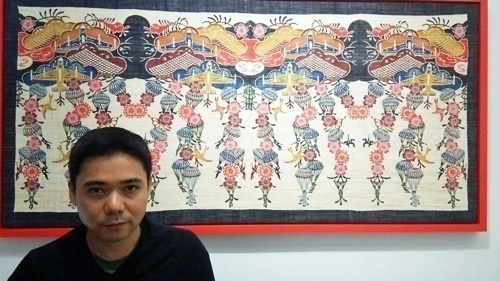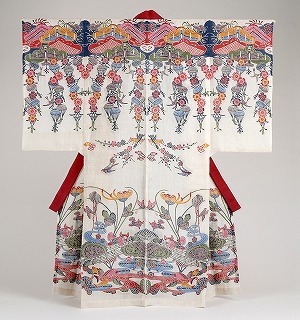New York-based artist Yuken Teruya: Make Okinawan protest movement cultural heritage

Yuken Teruya with his work "Yu-I" behind him at his studio in New York on November 9, 2015 (Photograph taken by Chota Takamine).
December 24, 2015 Ryukyu Shimpo
New York-based artist Yuken Teruya is known for Okinawan traditional bingata dye works, including one featuring parachuters, fighter aircraft, Osprey and dugong in a beautiful design. In an interview with freelance journalist Chota Takamine, the Okinawan artist talked about his position on U.S. military bases in Okinawa.
Q: What is your position on the construction of a new U.S. military base in Henoko?
A: I simply oppose it. I have lived in the United States for over 17 years, and have been invited to hold art exhibitions featuring the base issues of Okinawa. However, my main theme is how I can make American people feel connected with those issues. I think art is a suitable format to express this theme. By making art museums in Europe and the United States display pieces featuring the base issues of Okinawa, I want to make the Okinawan protest movement against the bases cultural heritage.

“Yu-I” bingata dye work featuring parachuters, fighter aircraft, Osprey, and dugong in a beautiful design (by Yuken Teruya).
Q: Do you have any suggestions on how to solve the base issues as an Okinawan who is based in New York?
A: American citizens are also struggling with various problems and debating over them. As represented by the Occupy Wall Street movement that occurred in 2011, each and every person in the United States continues to work on solving their problems. I think one idea is to let U.S. military personnel know why the people of Okinawa are against the bases from a common ground. For example, Okinawan people should hold picket signs saying, “Tax,” “You owe us electricity,” and let the military personnel know the Japanese citizens pay tax to maintain the U.S. bases in Japan. From common subjects such as tax, I want to exchange opinions with U.S. military personnel about burdens on both Okinawan people and them.
Q: You took part in sit-in protests against the new base construction in Henoko and helipads in Takae July 2015.
A: Although I have various ideas about how to protest, I feel frustrated at times because I cannot carry them out once I get there. I do not know whether or not my vision of the protest movement is clear or my commitment to the movement is enough. I cannot have enough communication with the people protesting. When I returned to Okinawa and took part in the protest, I sometimes ended up going back to the United States with dissatisfaction. My theme is to build relationships of trust and understanding with those protesting and carry out my own ideas of the protest while keeping some distance. I think it is effective to shed light on the base issues through art projects. Artworks can easily be accepted by the people in the U.S. bases.

“Parade From Far Far Away” bingata dye work telling the story of Okinawans parading in the future while looking back on history after the issues of the U.S. military bases in Okinawa have been solved (by Yuken Teruya).
When I took part in sit-in protests in Takae and Henoko, the people working for bases took photographs of me from inside of their cars and the fence. I was worried about whether or not I could safely return to the United States. My mother who used to be involved in a nature conservation movement, told me that you are not going to have any problems if you can explain your situation by arming yourself with a knowledge of laws. In order to do that, you need to learn your own rights by taking cognizance of the law. Some American scholar once said that you could say constitutions exist only if you can recognize and precisely talk about them. You cannot protect your own rights if you don’t study. In order to do that, I think debate is useful. You can deepen knowledge of laws and politics while having fun and interests through debate. I think Okinawa is the best place to do that.
I think the style of protests in Europe is sophisticated. It is not difficult to effectively use various styles for protesting. I think it is nice for Okinawan people overseas and those in Okinawa to work together.
Q: Do you have any advice for young Okinawans who want to become big overseas?
A: If you believe in your talent, it is enough. If you can do something that people in your region appreciate, you can do the same in the United States. Even though you are not acknowledged by your schools, you are the real deal if you can prove them wrong. Even if your talent continues to be ignored and you continue to miss the timing, I want you not to ignore what you want to do and your belief in what you can do. While some people appreciated me, others didn’t. I owe my entire career to a strong belief in my capability. Life in the United States is not easy. If you do not believe in yourself, you could ruin what you have done up to now.
You can find a unique way to work effectively in the field of art. It needs a different effort from company employees. It is important to manage your schedule as an artist and create artworks that can move people.
Biography:
Yuken Teruya was born in Haebaru Town, Okinawa in 1973. Teruya graduated from Tama Art University. After completing his master’s course at the School of Visual Arts in New York, he has been based in New York.
Chota Takamine was born in Naha City, Okinawa in 1978. Takamine graduated from the University of San Francisco, majoring in Media Studies. He works as a translator and journalist.
(English translation by T&CT)
Previous Article:Economic organizations pledge to make Okinawa’s economy play an active role in Asia
Next Article:New Year’s solemn ceremony at Shuri Castle
[Similar Articles]
- Junior High School art textbook introduces the work of Yuken Teruya
- Okinawan art exhibition to be held in New York
- New York demonstrators protest Henoko base, call to acquit Yamashiro
- American activist refers to Okinawa’s reversion to Japanese sovereignty with U.S. military presence intact as “fraud”
- Director of US peace organization visits Okinawa
 Webcam(Kokusai Street)
Webcam(Kokusai Street)


